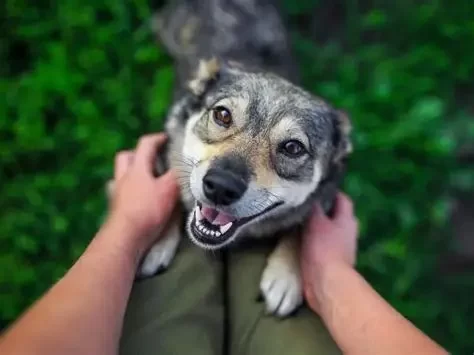- 1-understanding-why-dogs-jump
- 2-the-behavioral-psychology-behind-jumping
- 3-how-to-correct-dog-jumping-expert-tips
- 4-real-dog-owner-stories-and-solutions
- 5-when-to-seek-professional-guidance
1. Understanding Why Dogs Jump on People
1.1 A Natural Instinct Rooted in Greeting Rituals
Jumping is a behavior that stems from natural canine greetings. In the wild, puppies greet adult dogs by licking their faces. Domesticated dogs often mimic this by jumping up to reach our faces. While it may be adorable in a 10-pound puppy, it becomes problematic when your 60-pound lab greets guests the same way.
1.2 Seeking Attention and Reinforcement
Many dogs learn that jumping gets them what they want—your attention. Whether you laugh, push them away, or speak to them, they receive a response. For dogs, any reaction is often rewarding, even if it’s negative. Understanding this can shift how you handle the behavior.
2. The Behavioral Psychology Behind Jumping
2.1 Dogs Learn What Works
According to Dr. Cynthia Marks, a canine behaviorist from California, dogs are expert observers of human reactions. “If jumping results in treats, cuddles, or playtime—even occasionally—it reinforces the behavior,” she explains. Consistency in response is key to behavior modification.
2.2 Excitement vs. Anxiety Triggers
While most jumping is caused by excitement, some dogs jump due to stress or overstimulation. Dogs without clear boundaries may jump to relieve nervous energy. Identifying the root emotion behind the behavior is critical before implementing training strategies.
3. How to Correct Dog Jumping: Expert Tips
3.1 The “Four-On-The-Floor” Rule
This simple rule encourages dogs to keep all four paws on the ground. Reward calm, grounded behavior immediately. When your dog approaches and stays down, offer a treat or verbal praise. Timing is everything—rewards must come while the dog is grounded.
3.2 Ignoring the Jumping
Another widely supported method is to turn away and ignore the dog completely when it jumps. Don’t speak, touch, or make eye contact. The lack of attention teaches the dog that jumping achieves nothing. Once calm behavior returns, reward generously.
3.3 Redirect with a Sit Command
Teaching your dog to sit when greeting people replaces jumping with a positive behavior. Practice at home first with friends or family members, and reward consistently. Over time, sitting becomes your dog’s default greeting action.
4. Real Dog Owner Stories and Solutions
4.1 Max the Golden Retriever and the Surprise Visitor Incident
Max, a 3-year-old golden retriever from Michigan, was notorious for jumping on everyone, including delivery people. After an embarrassing incident where he knocked over a pizza guy, his owner Sarah consulted a local trainer. By implementing the “sit-to-greet” rule and using positive reinforcement, Max’s behavior changed within two weeks. Today, visitors are met with a wagging tail and polite posture.
4.2 Luna the Rescue Pup and Anxiety-Driven Jumping
Luna, a rescued shepherd mix, jumped excessively due to anxiety. Her foster mom, Jenna, noticed Luna jumped more when new people arrived. Hidden Brook Veterinary helped design a calming routine including structured walks, mental stimulation, and lavender sprays. Combined with training, Luna now greets guests without leaving the ground.
5. When to Seek Professional Guidance
5.1 Persistent Behavior Issues
If you’ve tried multiple strategies with little success, it may be time to consult a professional. Certified trainers or veterinary behaviorists can assess your dog’s temperament, home environment, and triggers to create a tailored plan. Resources like Hidden Brook Veterinary offer both in-person and remote consultations with behavior specialists.
5.2 Dogs with Additional Behavior Problems
Sometimes, jumping is just one part of a larger behavioral puzzle—such as separation anxiety, aggression, or lack of boundaries. Correcting jumping without addressing underlying causes will only lead to new challenges. A holistic approach guided by professionals is the best path forward.












